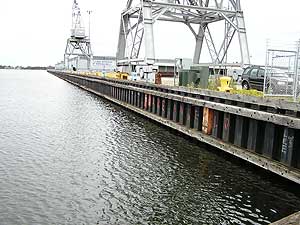|
Audio
Photos
Resources
Your Voice
|
The harbor that's rusting away
September 8, 2004
Corrosion is eating away at the steel walls that hold Duluth's harbor together - and nobody knows why it's happening. Fixing the metal walls could cost millions of dollars - without a fix the busy port could slide into the water - and out of business.
Duluth, Minn. — Jim Sharrow is the Duluth Seaway Port Authority's Facilities Manager - and he has a big problem with his facility. Some kind of corrosion is eating away at the port's docks - the long earth-filled metal rectangles where ships from around the world tie up to load and unload. Those docks are lined with sheets of steel, and the steel is rusting away.
"It's corroding quickly," Sharrow says. "Much faster than people expect in fresh water. And our main concern is that we'll lose the integrity and the strength of the dock long before expected, and have to do steel replacement at $1,500 or more per lineal foot, much earlier than ever would have been expected."
 | |||
Corrosion should be a slow process in Duluth's cold, fresh water. But there's evidence it's been happening remarkably quickly for about 30 years.
"What we seem to see here is corrosion that started in the mid 1970s," Sharrow says. "We have steel that's 100 years old that's about as similarly corroded to steel that is 25 to 30 years old."
It's a big problem. There's about 13 miles of steel walls lining docks in Duluth and Superior. There's half again as many feet of wooden docks, held together with steel pins. There's corrosion on the legs of highway bridges and the giant steel ore docks that ship millions of tons of taconite a year.
|
It's corroding quickly. Much faster than people expect in fresh water.
- Jim Sharrow |
"We characterize this as a $100 million problem in the harbor," Sharrow says. "It's a huge problem. And what is so odd about this is that we only see it happening in the navigational area of the Duluth-Superior Harbor."
The harbor links the St Louis River with Lake Superior. Go a few miles up the river and there's little corrosion.
Back in the harbor, the walls are covered with steel plates three-eights inch to one-half inch thick. At the rate of corrosion, Sharrow says, the steel will fail quickly.
"I figure that in about 10 years at the current rate, we will have to start replacing steel," Sharrow says.
One busy grain shipping dock has already done that, for millions of dollars. But Sharrow says some waterfront businesses might find the price tag too high.
"Particularly marginal operators could decide rather than repair their docks it would be better for them to go out of business, and we're hoping that that isn't the case here," says Sharrow.
 | |||
While the cause is a mystery, there's no shortage of theories. It could have something to do with stray electrical voltage, water acidity, or the kinds of steel manufactured in recent years.
Chad Scott discovered the corrosion in the late 1990's. He's an engineer and diver. Scott suspects a micro-biological connection. He says there might be something growing in small round pits that form on the steel.
"We cleaned up the water." Scott says. "That's the main thing - that's one of the main changes that's happened since the 70s, is we've cleaned up our water. We've cleaned up our harbor, which is a good thing," says Scott. "But, when we cleaned things up we also induced more dissolved oxygen and more sunlight can penetrate the water, which tends to usually promote more growth - more marine microbiology growth."
 | |||
A team of experts is in Duluth this week to share ideas. They come from the U.S. Navy, The Army Corp of Engineers, and Ohio State University. They're not likely to find a cause, but Scott says they might be able to narrow the focus.
"We have a large laundry list right now," Scott says. "We want to narrow that down and try to decide what is the real cause of this corrosion. And these experts, hopefully, will be able to get us going on the right direction, so we can start doing testing that will identify the problem."
With the experts recommendations in hand, port officials will start a study. If they do figure out the cause, then they've got to figure out how to prevent it. They're in a race with something, and right now they don't even know with what.
|
News Headlines
|
Related Subjects
|

